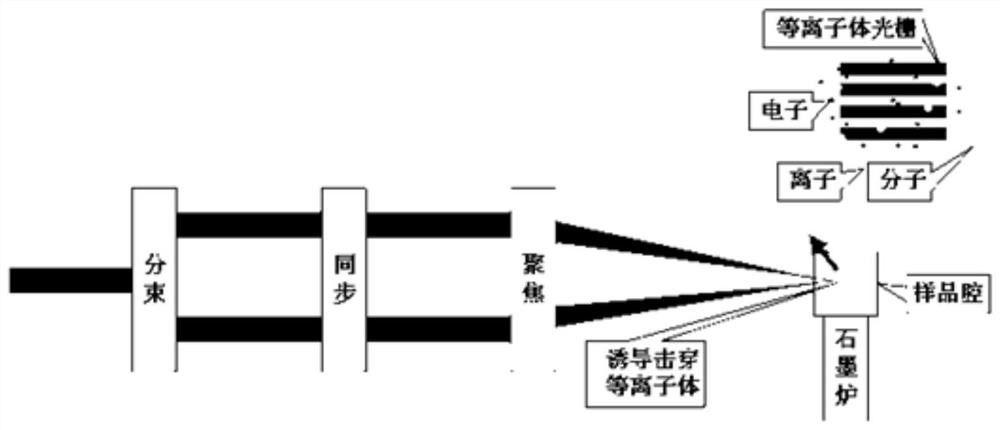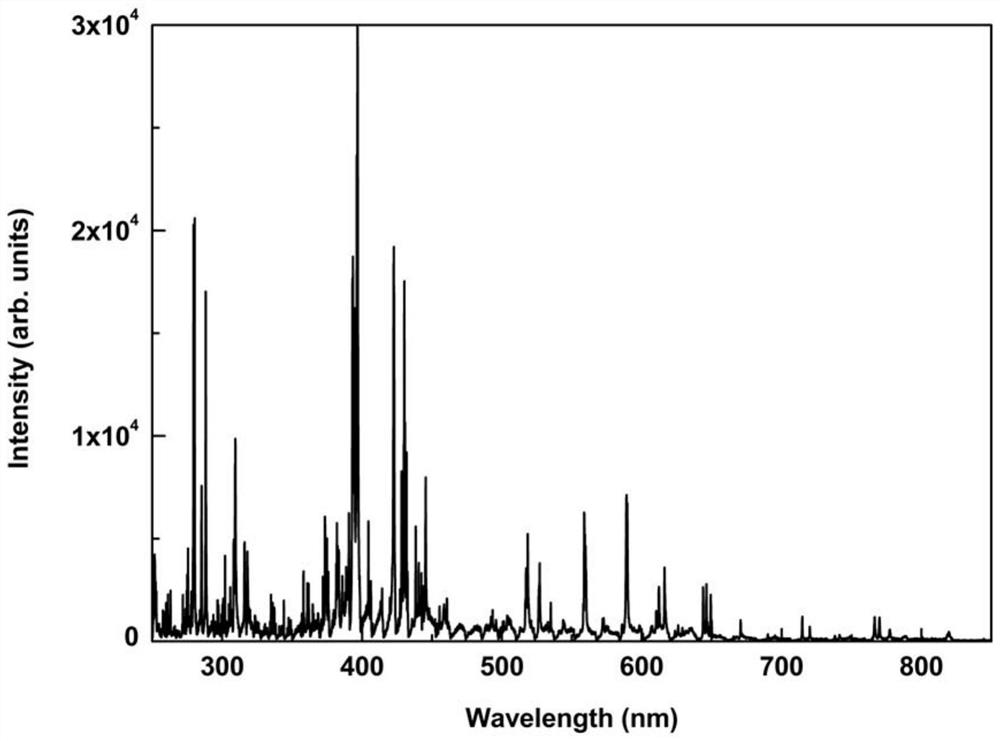Method and device for spectral detection of femtosecond plasma breakdown ionization
A plasma and spectral detection technology, which is applied in the field of element detection, can solve the problems of no strong background spectrum, etc., and achieve the effects of overcoming adverse effects, easy ionization, and simple optical path design
- Summary
- Abstract
- Description
- Claims
- Application Information
AI Technical Summary
Problems solved by technology
Method used
Image
Examples
Embodiment 1
[0038] like figure 1 As shown, a device for spectral detection of femtosecond plasma breakdown ionization includes a graphite heating device 5, a sample cavity 6 and a detection module. The detection module includes a laser emission module 1, a focusing The module 4 and the spectrum collection and detection module 7, the graphite heating device 5, the focusing module 4 and the spectrum collection and detection module 7 are connected to the sample chamber 6 respectively. A beam splitting module 2 and a time domain synchronization module 3 are arranged in sequence between the laser emitting module 1 and the focusing module 4 along the laser emitting path.
[0039] The outgoing light of the laser emitting module 1 is divided into two laser beams with an energy ratio of 1:1 by the beam splitting module 2. After passing through the optical path synchronization module 3, it is focused into filaments by the focusing module 4, and the two laser beams are adjusted to intersect in space...
Embodiment 2
[0042] A method for spectral detection of femtosecond plasma breakdown ionization, adjusting the temperature of the graphite heating device 5 to 2000°C, placing the soil sample to be tested in it, and after ashing and atomization, the soil atomization gas is formed and injected into the In the sample cavity 6; split the femtosecond laser pulse with a single pulse energy of 1.6mJ and a repetition rate of 1kHz through a 1:1 beam splitter, and then adjust the optical path synchronization of the two pulses to form an optical filament through the same focusing lens. Adjust the spatial intersection to form a plasma grating, apply the grating to the sample cavity for excitation, and use a high-resolution spectrometer to collect lateral fluorescence. The test spectrum is as follows: image 3 As shown, the detection characteristic lines of several typical metal elements can be clearly seen, such as magnesium element 285.2nm, calcium element 422.7nm, sodium element 589.0nm, potassium ele...
Embodiment 3
[0044] Adjust the temperature of the graphite heating device to 3000°C, place the soil sample to be tested in it, and after ashing and atomization, the atomized soil gas is formed and injected into the sample chamber; the femtosecond The laser pulse is split by a beam splitter of 1:1, and then the optical path of the two pulses is adjusted to be synchronized to form a filament through the same focusing lens, and the spatial intersection is adjusted to form a plasma grating, and the grating acts on the sample cavity for excitation. At the same time, a high-resolution spectrometer is used for lateral fluorescence collection, and the test spectrum is as follows: Figure 4 As shown, the detection characteristic lines of several typical metal elements can be clearly seen, such as magnesium element 285.2nm, calcium element 422.7nm, sodium element 589.0nm, potassium element 769.9nm, silicon element 288.2nm, etc., which have very good SNR.
PUM
 Login to View More
Login to View More Abstract
Description
Claims
Application Information
 Login to View More
Login to View More - R&D
- Intellectual Property
- Life Sciences
- Materials
- Tech Scout
- Unparalleled Data Quality
- Higher Quality Content
- 60% Fewer Hallucinations
Browse by: Latest US Patents, China's latest patents, Technical Efficacy Thesaurus, Application Domain, Technology Topic, Popular Technical Reports.
© 2025 PatSnap. All rights reserved.Legal|Privacy policy|Modern Slavery Act Transparency Statement|Sitemap|About US| Contact US: help@patsnap.com



